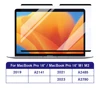Let’s look back at 2022, a year when Apple redesigned the standard iPad without a Home button, and the iPad Pro upgraded from the M1 chip to the M2. After those releases, it was over a year before Apple updated the iPad line again, which resulted in the iPad mini going three years between updates, and the iPad Air two years. It led to a sense that the iPad was done. After all, iPhones got getting bigger and bigger, and the MacBook Air has always been an ideal mobile laptop. What’s the point of the iPad?
That gap in time proved to be a hiccup. The tablet made its comeback in March 2024 with the iPad Pro (which was the first Apple device to be equipped with an M4 chip; the M4 MacBook Pro was released 6 months later), and the M3 iPad Air. Apple subsequently launched an iPad mini with the A17 Pro chip, which can run Apple Intelligence, and the 11th-generation iPad with an A16 chip, an affordable tablet but it lacks Apple Intelligence support.
Even the rumor mill is in full swing, with reports of an M5 iPad Pro coming later this year, and an M4 iPad Air in development, with a possible release in 2026.
But, why?
The iPad slump is over, and Apple’s tablet is sailing close to the wind. But why do we still need an iPad at all, when it is being cannibalized from two sides? On one side are large and powerful iPhones, and on the other is the powerful and portable MacBook Air.
Apple’s answer to this question is currently iPadOS 26, but it actually exacerbates the issue. I like iPadOS 26’s approach; the new window management and the revised Files app make the iPad more like a Mac than ever before. But macOS is the better system, so why not just buy a Mac?
To take full advantage of iPadOS 26 requires a decent keyboard with a trackpad, and only Apple’s Magic Keyboard Folio or the Magic Keyboard for the iPad Pro and Air are suitable (for now). The 13-inch M4 iPad Pro with 256GB of storage and a Magic Keyboard costs $1,648/£1,648, $649/£649 more than the $999 MacBook Air!
What the iPad can do and the MacBook can’t
The iPad can be used without a keyboard, and Apple Pencil offers a form of input that is difficult to match on a Mac. Without a keyboard and case, the iPad Pro is also much lighter than the MacBook Air. Try using a MacBook in portrait mode or as a camera!
For use in education or as a mobile work tool, the iPad is certainly better suited than a MacBook Air, as a robust and lightweight device that can also be operated with a stylus.
There are arguments for using an iPad or a MacBook depending on the situation. But this is where the second cannibal comes into play: the iPhone. It takes even better pictures, is much easier to attach to a controller when playing games, and can even make phone calls.
Is the iPhone a better iPad?
I use the iPhone more and more often for the purposes for which I used to like using the iPad. Reading the news works almost as well, as does quickly replying to an email or message. When I’m typing longer texts, it almost doesn’t matter whether I pull out the iPad (and possibly have to search for the keyboard first) or open up the MacBook Air–like the iPad, it’s quickly unlocked and then ready to use straight away.
Apple has always taken the stance that it’s better to cannibalize itself than let others eat away at its marketshare. That’s a good strategy in itself. However, the iPad has to fend off two cannibals from its own company, and I don’t know if that will work for long.
Despite the remarkable innovations in iPadOS 26, Apple is not planning to combine the iPad with the Mac in a single device; rather, the iPad will have to fear a completely different competitor from its own company: a foldable iPhone, which reports indicate will be released next year.
iPad tests technologies
Apple has shown a willingness to experiment with the iPad. For example, Apple first built a lidar into an iPad Pro before it was used in the iPhone 12 Pro, and an OLED screen made its debut in the M4 iPad Pro before the MacBook. Tech that Apple could try in the iPad includes Face ID under the screen, especially if the iPad Pro M5 will indeed have two front cameras.
Apple is always good for a surprise, and the iPad has been declared dead before and continues to enjoy the best of health. Even other seemingly dead products didn’t end up on the sidelines because they were unrivalled in their niche, such as the MacBook Air and the Mac mini, which Apple brought back into the limelight from the sidelines at the end of 2018.
The iPad could therefore join forces with its two cannibals to form an infernal trio and nibble away at the competition.





